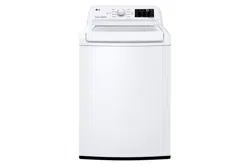Documents: Go to download!
- Owner's manual - (English, French, Spanish)
- INSTALLATION
- OPERATION
- Care in Cold Climates
- TROUBLESHOOTING
Table of contents
User manual Washer for LG Electronics WT7100CW
INSTALLATION
Choosing the Proper
Location Install the washer on a solid floor that is strong and rigid enough to support the weight of the washer, even when fully loaded, without flexing or bouncing. If the floor has too much flex, you may need to reinforce it to make it more rigid. If the floor is not solid, it may cause severe vibration and noise.
NOTE
- Before installing the washer, make sure the floor is clean, dry and free of dust, dirt, water and oil so the washer feet cannot slide easily. Leveling feet that can move or slide on the floor can contribute to excess vibration and noise due to poor contact with the floor.
- Allow for sufficient space between the walls and the washer for installation.
Power Outlet
- The power outlet must be within 60 inches (1.5 m) of either side of the washer.
- The appliance and outlet must be positioned so that the plug is easily accessible.
- Do not overload the outlet with more than one appliance.
- The outlet must be grounded in accordance with current electrical wiring codes and regulations.
- Use a time-delay fuse or circuit breaker.
Flooring
- To minimize noise and vibration, the washer must be installed on a solidly constructed floor.
- Allowable slope under the entire washer is a maximum 1 inch difference from side to side or from front to back.
- Installing on carpeting and soft tile surfaces is not recommended.
- Never install the washer on a platform or weakly supported structure
Floor Installation
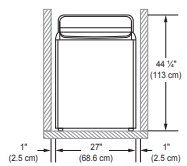
To ensure sufficient clearance for water lines, the drain line and airflow, allow minimum clearances of at least 1 inch (2.5 cm) at the sides and 4 inches (10 cm) behind the unit. Be sure to allow for wall, door, or floor moldings that may increase the required clearances.
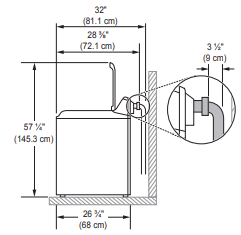
- Minimum vertical space from floor to overhead shelves, cabinets, ceilings, etc., is 58 inches (147 cm).
Connecting the Water Lines
To avoid the risk of costly water damage, purchase and install new inlet hoses when installing the washer.
- Check the fittings and seals. Inspect the threaded fitting on each hose and make sure there is a rubber seal in place in both ends of each hose to prevent leaking.

- Connect the water supply hoses. Connect the water supply hoses to the hot and cold water faucets tightly by hand and then tighten another 2/3 turn with pliers. Connect the blue hose to a cold water faucet and the red hose to a hot water faucet.

- Flush out the inlet hoses. After connecting the inlet hoses to the water faucets, turn on the water faucets to flush out foreign substances (dirt, sand or sawdust) in the water lines. Let water drain into a bucket, and check the water temperature to make sure you've connected the hoses to the correct faucets.

- Attach the water lines to the back of the washer. Attach the hot water line to the hot water inlet on the back of the washer. Attach the cold water line to the cold water inlet on the back of the washer. Tighten the fittings securely. Turn ON both faucets all the way and check for leaks at both ends of the hoses.

NOTE
- Periodically check the hoses for cracks, leaks, and wear, and replace the hoses every five years. Do not stretch the water hoses intentionally, and make sure that they are not pinched, crushed or kinked by other objects.
- Water supply pressure must be between 20 psi and 120 psi (138 – 827 kPa). If the water supply pressure is more than 120 psi, a pressure reducing valve must be installed.
- To provide optimum washing performance, the hot water temperature should be set at 120 – 135 °F (48 – 57 °C) and the cold at 60 °F (15 °C).
- The washer should never be installed or stored in a location subject to freezing temperatures. Damage to the water lines and internal mechanisms of the washer can result. If the washer was exposed to freezing temperatures prior to installation, allow it to stand at room temperature for several hours before use and check for leaks prior to operation.
- Do not use flood-preventing hoses with auto shutoff devices. The devices can be tripped during fill and prevent the machine from filling properly.
Connecting the Drain Hose
Connect the drain hose to either a standpipe or laundry tub.
NOTE
- The drain hose should always be properly secured. Failure to properly secure the drain hose can result in flooding and property damage.
- The drain must be installed in accordance with any applicable local codes and regulations.
- Make sure that the drain hose is not stretched, pinched, crushed, or kinked.
- Do not install the drain hose with the end lower than 29.5 inches (75 cm) or higher than 96 inches (244 cm) above the bottom of the washer or more than 60 inches (152 cm) away from the washer.
- Never create an airtight seal between the hose and the drain with tape or other means. If no air gap is present, water can be siphoned out of the tub resulting in poor wash/rinse performance or clothing damage.
- Normal height of the end of the hose should be approximately 35 inches (89 cm) to 47 inches (120 cm) from the floor.
Option 1: Standpipe
- Insert the end of the drain hose into the standpipe.
- Use the provided tie strap to secure the drain hose in place.

- If the water valves and drain are built into the wall, fasten the drain hose to one of the water hoses with the tie strap provided (ribbed side on inside).

Option 2: Laundry Tub
- Hang the end of the drain hose over the side of the laundry tub.
- Use the provided tie strap to secure the drain hose in place.
Position the washer in its final location. Take special care not to pinch, strain, or crush the water and drain lines. If you have a carpenter’s level, you can use it to check that the washer level. The slope beneath the washer should not exceed 1 inch, and all four leveling feet must rest firmly on the floor.
Open the lid (door) and look from above to see if the tub is centered. If the tub is NOT centered, readjust the front feet. If you have a level, check the washer with the level.
Adjust the lower leveling feet. Turn in one direction to raise the washer or the other direction to lower it.
Recheck the washer’s levelness. Push or rock the top edges of the washer gently to make sure the washer does not rock. If the washer rocks, repeat steps 1-3.
Leveling the Washer
The tub of the washer spins at very high speeds. To minimize vibration, noise, and unwanted movement, the floor must be a level, solid surface.
- Position the washer in its final location. Take special care not to pinch, strain, or crush the water and drain lines. If you have a carpenter’s level, you can use it to check that the washer level. The slope beneath the washer should not exceed 1 inch, and all four leveling feet must rest firmly on the floor.
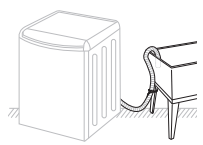
- Open the lid (door) and look from above to see if the tub is centered. If the tub is NOT centered, readjust the front feet. If you have a level, check the washer with the level.
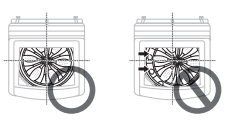
- Adjust the lower leveling feet. Turn in one direction to raise the washer or the other direction to lower it.
- Recheck the washer’s levelness. Push or rock the top edges of the washer gently to make sure the washer does not rock. If the washer rocks, repeat steps 1-3.

OPERATION
Cycle Modifier Buttons
Each cycle has default settings that are selected automatically. You may also customize these settings using the cycle modifier buttons. Press the button for the desired modifier until the indicator light for the desired setting is lit. The washer automatically adjusts the water level for the type and size of wash load for best results and maximum efficiency. Due to the high-efficiency nature of this product, water levels may be much lower than expected. This is normal and cleaning/rinsing performance will not be compromised.
NOTE
- To protect your garments, not every wash temperature, spin speed, soil level, or option is available with every cycle. A chime will sound and the LED will not light if a selection is not allowed.
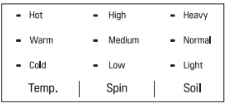
Temp.
Temp. selects the wash and rinse temperature combination for the selected cycle.
- Press the Temp. button until the indicator light for the desired setting is lit.
- All rinses use tap cold water.
NOTE
- Select the water temperature suitable for the type of load you are washing. Follow the fabric care labels on the garment for best results.
Spin
Higher spin speeds extract more water from clothes, reducing drying time and saving energy.
- Press the Spin button until the desired speed is selected.
- Some fabrics, such as delicates, require a slower spin speed. To protect your clothing, not all spin speeds are available for all cycles.
Soil
Adjusting the soil level setting will modify the cycle times and/or wash actions.
- Press the Soil button until the desired soil level is selected.
NOTE
- This feature needs more time for heavily soiled loads or less time for lightly soiled loads.
Spin Only
Use this option to drain the water from the tub and spin the clothes. This can be used, for example, if the wash cycle is interrupted by a power failure. The spin speed can be adjusted using the Spin button.
- To use this option, do not select a cycle.
- Press the Power button to turn on the washer.
- Press and hold the Spin button for 3 seconds.
- Press the Start/Pause button.
Cold Wash
This option saves energy by using cooler water while increasing the wash and rinse times to maintain wash performance.
NOTE
- Wash time will increase up to several minutes with this option.
- For best wash results, only wash small loads (less than 8 lb.) with this option.
Signal
The washer plays a melody when the wash cycle is finished. The buttons make a sound each time a button is pressed. Use this option to adjust the volume of the melody and button tones.
- Press and hold the Cold Wash button for 3 seconds to adjust the volume of the signal.
- Press the button repeatedly to adjust the volume of the melody.
- When no signal is heard, the signal is off. The volume settings are Off or On. The signal volume can be adjusted at any time as long as the washer is turned on.
Delay Wash
- Once you have selected the cycle and other settings, press this button to delay the start of the wash cycle.
- Each press of the button increases the delay time by 1 hour, for up to 19 hours. Once the desired delay time is set, press the Start/Pause button to start the delay time.
NOTE
- If the Start/Pause button is not pressed to begin the delay time, the washer will automatically shut off after 60 minutes and all cycle settings will be lost.
Rinse+Spin
Select this option to rinse and spin a load separately from a regular cycle. This can be helpful in preventing fresh stains from setting in fabrics.
- You can change the spin speed by pressing the Delay Wash button.
- To use this option, do not select a cycle.
- Press the Power button to turn on the washer.
- Press and hold the Rinse+Spin button for 3 seconds.
- Press the Start/Pause button.
Water Plus
Use this option to add extra water to the wash cycle for better wash performance (stain treatment) with large or bulky items.
NOTE
- If the washer reaches its maximum water level, the Water Plus button will have no effect.
- To add more water while a cycle is running, pause the cycle before pressing Water Plus.
- When Normal cycle is selected, if you select Water Plus option, cycle will be changed to Deep Wash cycle before starting.
Soak
This option provides a 30-minute presoak prior to the start of the selected cycle. Use the Soak option to presoak garments to help remove difficult spots or stains on fabrics. At the end of the presoak time, the selected cycle will begin with the same water used for soaking.
- Press and hold the Water Plus button for 3 seconds to activate or deactivate Soak.
Extra Rinse
This option will add an extra rinse to the selected cycle. Use this option to help ensure the removal of detergent or bleach residue from fabrics. Liquid fabric softener, if used, is always dispensed in the final rinse.
- Pressing the Extra Rinse button twice will add two additional rinses to the cycle.
NOTE
- You cannot select the Extra Rinse option with the Spin Only option and Tub Clean cycle.
- When Normal cycle is selected, if you select Extra Rinse option, cycle will be changed to Deep Wash cycle before starting.
Control Lock
Use this option to disable the controls. This feature can prevent children from changing cycles or operating the machine. The feature does not lock the lid (door). Once the Control Lock is set, it must be deactivated before any controls, except the Power button, can be used. Once the washer has shut off, the Power button will allow the machine to be turned on, but the controls will still be locked. When the controls are locked,  will display alternately with the estimated time remaining.
will display alternately with the estimated time remaining.
- Press and hold the Extra Rinse button for 3 seconds to activate or deactivate Control Lock.
NOTE
- Once the controls are locked, they must be manually unlocked to restore operation.
Add Garment
Use this function to add garments or remove foreign objects like coins or keys after the cycle has started.
- Press the Start/Pause. The cycle pauses and the lid (door) unlocks.
- Open the lid (door), add garments or remove foreign objects, and close the lid (door).
- Press the Start/Pause button to start the cycle. The cycle continues automatically.
MAINTENANCE
Care After Wash
After the cycle is finished, wipe the lid (door) and the inside of the lid (door) seal to remove any moisture.
- Leave the lid (door) open to dry the tub interior.
- Wipe the body of the washer with a dry cloth to remove any moisture.
Cleaning the Exterior
Proper care of your washer can extend its life.
Lid (Door):
Wash with a damp cloth on the outside and inside and then dry with a soft cloth.
Exterior:
- Immediately wipe off any spills.
- Wipe with a damp cloth.
- Do not touch the surface or the display with sharp objects.
Care and Cleaning of the Interior
- Use a towel or soft cloth to wipe around the washer lid (door) opening and lid (door) glass.
- Always remove items from the washer as soon as the cycle is complete. Leaving damp items in the washer can cause wrinkling, color transfer, and odor.
- Run the Tub Clean cycle once a month, or more often if needed, to remove detergent buildup and other residue.
Cleaning the Tub
Over time, residue may build up in the tub, leading to mildew or a musty odor. Run the Tub Clean cycle monthly to remove residue and prevent odor. Run the cycle more often under heavy use conditions or if odor is already present.
- Remove any clothing from the tub.
- Add cleaning agents.

For other tub cleaning products, follow the cleaner manufacturer’s instructions and recommendations.
Do not exceed the maximum fill line when adding bleach or powdered cleaners. Powdered cleaners may remain in the tub after cleaning.
- Close the lid (door) and press the Power button to turn the washer on.
- Turn the knob or press the cycle buttons to select the Tub Clean cycle then press the Start/Pause button to begin the cycle.
- After the cycle ends, open the lid (door) and allow the tub interior to dry completely.
NOTE
- Never load laundry while using Tub Clean. The laundry may be damaged or contaminated with cleaning products. Make sure to run the Tub Clean cycle only when the tub is empty.
- Leave the lid (door) open after finishing the laundry, to keep the tub clean.
- Tub Clean should be repeated monthly.
- If mildew or musty smell already exists, run Tub Clean once a week for three consecutive weeks.
- Do not exceed the manufacturer's recommended amount when adding bleach or powdered cleaners. Powdered cleaner may remain in the tub after cleaning.
Removing Mineral Buildup
In areas with hard water, mineral scale can form on internal components of the washer. Periodically clean the mineral buildup on the internal components to extend the lifespan of the washer. Use of a water softener is recommended in areas with hard water.
- Use a descaler, such as Washer Magic®, to remove visible mineral buildup on the washer tub.
- After descaling, always run the Tub Clean cycle before washing clothing.
- Mineral scale and other spots may be removed from the stainless steel tub using a soft cloth soaked in stainless steel cleaner.
- Do not use steel wool or abrasive cleaners.
Leaving the Lid (Door) Open
- If the washer will not be used for several days, leave the lid (door) open overnight to allow the tub to dry.
Cleaning the Dispenser Drawer
Detergent and fabric softener may build up in the dispenser drawer. Remove the drawer and inserts and check for buildup once or twice a month.
- Remove the drawer by pulling it straight out until it stops. Lift up on the front of the drawer and pull it completely out.

- Remove the inserts from the two compartments.
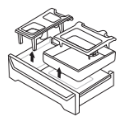
- Clean the inserts and drawer with warm water. Use a soft cloth or brush for cleaning and to remove any residue.
- Wipe off any moisture with a dry towel or cloth after cleaning.
- To clean the drawer opening, use a small, non- metal brush to clean the recess. Remove all residue from the upper and lower parts of the recess.
- Return the inserts to the proper compartments and replace the drawer. Set the drawer into the opening at an angle, then lower it and slide it into place.
NOTE
- If you use a descaler or tub cleaner during the Tub Clean cycle, use the Rinse+Spin option to rinse the washer tub before running your next wash cycle.
Cleaning the Water Inlet Filters
If the washer does not fill properly, an error message will show on the display. The inlet valve filter screens could be plugged by hard water scale, sediment in the water supply, or other debris.
- Turn off both water faucets completely.
- Unscrew the hot and cold water hoses from the back of the washer.
- Carefully remove the filters from the water valves.
- Remove foreign objects and soak the filters in white vinegar or a lime scale remover. If using a lime scale remover, follow the manufacturer’s instructions. Be careful not to damage the filters while cleaning them.
- Rinse filters thoroughly and press them back into place.
- Flush then reattach the water hoses. Before reattaching the hoses, flush the hoses and water lines by running several gallons of water into a bucket or drain, preferably with the faucets wide open for maximum flow.
Care in Cold Climates
Storing the Washer
If the washer will not be used for an extended period of time and is in an area that could be exposed to freezing temperatures, perform the following steps to protect the washer from damage.
Make sure the tub is empty before following these steps.
- Turn off the water supply.
- Disconnect hoses from water supply and drain water from hoses.

- Plug the power cord into a properly grounded electrical outlet.
- Add 1 gallon of nontoxic recreational vehicle (RV) antifreeze to the empty tub and close the lid (door). Never use automotive antifreeze.
- Press the Power button, then select Spin.
- Press the Start/Pause button to start the drain pump.
- Allow the drain pump to run for one minute, then press the Power button to shut off the washer. This will expel some of the antifreeze, leaving enough to protect the washer from damage.
- Unplug the power cord, dry the tub interior with a soft cloth, and close the lid (door).
- Store the washer in an upright position.
- Remove the inserts from the dispenser. Drain any water in the compartments and let them dry.
- To remove the antifreeze from the washer after storage, run a complete Speed Wash cycle using detergent. Do not add laundry to this cycle.
When the Water Line is Frozen
- Turn off the faucets connected with the water lines.
- Pour hot water on the frozen faucets to thaw the water lines and remove water lines.
- Immerse the water lines in hot water to thaw them.
- Connect the water lines with the water inlets of the washer and with the faucets. See Connecting the Water Lines for details.
- Turn on the faucets.
- Press the Power button.
- Press and hold the Rinse+Spin button for 3 seconds.
- Press the Start/Pause button. Verify the water fills properly.
When the Drain Line is Frozen
- Pour hot water in the washer tub and close the lid. Wait for 1-2 hours.
- Press the Power button after thawing.
- Press and hold the Rinse+Spin button for 3 seconds to select draining and spinning.
- Press the Start/Pause button. Check to make sure the water drains.
TROUBLESHOOTING
Noises You Might Hear
Clicking
- Lid (Door) lock relays when the lid (door) locks and unlocks.
Normal Operation
Spraying or Hissing
- Water spraying or circulating during the cycle.
Normal Operation
Humming or Gurgling
- Drain pump is pumping water from the washer at times during a cycle.
Normal Operation
Water sloshing
- A liquid in the balance ring around the wash basket helps the basket spin smoothly.
Normal Operation
Water being added after the washer has already begun to operate
- The washer adapts to the load size and type to add more water to the cycle as needed.
- The wash load may be unbalanced. If the washer senses that the load is unbalanced, it will stop and refill to redistribute the load.
- The washer may be diluting laundry additives to add to the wash load.
Normal Operation
Rattling and clanking noise
- Foreign objects, such as keys, coins, or safety pins may be in tub or pump.
Stop washer, check tub and drain filter for foreign objects. If noise continues after washer is restarted, call for service.
Thumping sound
- Heavy wash loads may produce a thumping sound.
This is normal. If sound continues, washer is probably out of balance. Stop and redistribute wash load.
- Wash load may be out of balance.
Pause the cycle and redistribute the load after the lid (door) unlocks.
Vibrating noise
- Packaging materials were not removed.
See Unpacking and Removing Shipping Material in the Installation section.
- Wash load may be unevenly distributed in the drum.
Pause the cycle and redistribute the load after the lid (door) unlocks.
- Not all leveling feet are resting firmly and evenly on the floor.
See Leveling the Appliance in the Installation section.
- Floor not rigid enough.
Make sure that the floor is solid and does not flex. See Flooring in the Installation section.
Squeaking noise
- Packaging materials were not removed
See Unpacking and Removing Shipping Material in the Installation section.
Banging noise when washer is filling with water (Water Hammer)
- Plumbing in the home moves or flexes when the water valves in the washer shut off.
Water hammer is not caused by a defect in the washer. Install water hammer arrestors (purchased separately at hardware or home improvement store) between the fill hose and the washer for best results.
- Household water supply pressure is very high.
Adjust household water supply regulator to a lower pressure or contact a plumber.
Operation
Water leaking
- Hoses are not connected correctly
Check hoses and connectors for leaks, cracks and splits.
Check and tighten hose connections.
- House drain pipes are clogged.
The washer pumps out water very rapidly. Check for water backing up out of the drain pipe during drain. If water is seen coming out of the drain, check for proper drain hose installation and check for restrictions in the drain. Contact a plumber to repair drain pipe.
- Drain hose has come out of drain connector or is not inserted far enough.
Tie drain hose to inlet hose or standpipe to prevent it from coming out during drain. For smaller drain pipes, insert the drain hose into the pipe as far as the drain hose flange. For larger drain pipes, insert the drain hose into the pipe 1-2 inches past the flange.
- A large item such as a pillow or blanket is above the top of the tub.
Use the Bedding cycle for large or bulky items. Use extra care and never wash more that half a load of items that float, such as pillows.
Stop the washer and check the load. Make sure the load does not crest above the top edge of the tub.
- Oversudsing of detergent.
Oversudsing may create leaks, and may be caused by the type and amount of detergent used. High-Efficiency detergent is the only detergent recommended. The normal amount of detergent to use is 1/4 to 1/2 of the maximum amount recommended by the detergent manufacturer. Always reduce the amount of detergent if the load is small or lightly soiled, or if the water is very soft. Never use more than the maximum amount recommended by the detergent manufacturer.
Water leaks every load.
- Hoses are not installed correctly
Check all fill and drain hose connections to ensure that they are tight and secure.
Excessive sudsing
- Too much detergent or incorrect detergent.
HE detergents are formulated specifically for High-Efficiency washers and contain sudsreducing agents. Only use detergent with the High-Efficiency (HE) logo.
For detergent quantities refer to the Detergent Use section. If sudsing or detergent residue continue to be an issue, add an extra rinse.
Washer will not turn on.
- Power cord is not properly plugged in.
Make sure that the plug is plugged securely into a grounded, 3-prong, 120-VAC, 60 Hz outlet.
- House fuse is blown, circuit breaker has tripped, or power outage has occurred.
Reset circuit breaker or replace fuse. Do not increase fuse capacity. If the problem is a circuit overload, have it corrected by a qualified electrician.
Wash cycle time is longer than usual.
- The washer automatically adjusts the wash time for the amount of laundry, water pressure and other operating conditions.
This is normal. The washer adjusts cycle time automatically to provide optimal results for the selected cycle. The time remaining shown in the display is only an estimate. Actual time may vary.
Incomplete or no dispensing of detergent
- Detergent compartments clogged from incorrect filling.
Make sure that detergent and additives are put into the correct dispenser compartments. For all detergent types, always make sure that the dispenser drawer is fully closed before the start of the cycle.
- Too much detergent used.
Make sure that the suggested amount of detergent is used per the manufacturer’s recommendations. You may also dilute the detergent with water to the maximum fill line on the compartment to avoid clogging. Use only HE (High-Efficiency) detergent. NOTE: Always use as little detergent as possible. High-Efficiency washers need very little detergent to achieve optimum results. Using too much detergent will cause poor wash and rinse performance and may contribute to odors in washer.
- Insufficient water supply
Make sure that both hot and cold water faucets are turned on all the way
- Normal residue
It is normal for a small amount of detergent to remain in the dispenser. If this residue builds up it can interfere with normal dispensing of products. Refer to the cleaning instructions.
Washer will not operate.
- Control panel has powered off due to inactivity
This is normal. Press the Power button to turn the washer on.
- Washer is unplugged.
Make sure cord is plugged securely into a working outlet.
- Water supply is turned off.
Turn both hot and cold faucets fully on.
- Controls are not set properly.
Make sure the cycle was set correctly, close the lid (door) and press the Start/Pause button.
- Lid (Door) is open.
The washer will not operate if the lid (door) is open. Close the lid (door) and make sure that nothing is caught under the lid (door) preventing it from closing completely.
- Circuit breaker/fuse is tripped/ blown.
Check house circuit breakers/fuses. Replace fuses or reset breaker. The washer should be on a dedicated branch circuit. The washer will resume the cycle where it stopped once power is restored.
- Control needs to be reset.
Press the Power button, then re-select the desired cycle and press the Start/Pause button.
- Start/Pause was not pressed after a cycle was set.
Press the Power button then re-select the desired cycle and press the Start/Pause button. The washer will shut off if the Start/Pause button is not pressed within 60 minutes.
- Extremely low water pressure.
Check another faucet in the house to make sure that household water pressure is adequate.
- Washer is too cold.
If the washer has been exposed to temperatures below freezing for an extended period of time, allow it to warm up before pressing the Power button. Otherwise, the display will not come on.
Washer is not filling properly.
- Filter clogged.
Make sure the inlet filters on the fill valves are not clogged. Refer to the filter cleaning instructions.
- Inlet hoses may be kinked.
Check that inlet hoses are not kinked or clogged.
- Energy efficiency
This is a High-Efficiency (HE) washer. As a result, the water level settings for this washer may be different than for conventional washers.
- Insufficient water supply
Make sure that both hot and cold water faucets are turned on all the way
- The washer lid (door) is open.
The washer will not operate if the lid (door) is open. Close the lid (door) and make sure that nothing is caught under the lid (door) preventing it from closing completely.
- Water level is too low.
The water will not normally cover the clothes. The fill level is optimized for the wash motion to achieve the best wash performance.
Water in the washer does not drain or drains slowly
- Drain hose is kinked, pinched, or clogged.
Make sure the drain hose is free of clogs, kinks, etc., and is not pinched behind or under the washer.
- Drain discharge is more than 96 inches (2.4 m) above bottom of washer.
Move the end of the drain hose so it’s lower than 96 inches (2.4 m) above the bottom of the washer.
Bleach does not dispense
- Bleach dispenser cover is not properly installed.
Make sure that the bleach cover is properly installed and snapped into place before the beginning of the cycle.
- Bleach dispenser is dirty or clogged.
Lift out the bleach dispenser cover and clean out the reservoir. Lint and other foreign debris that collects in the inside the dispenser may prevent proper dispensing of the bleach.
Premature dispensing of bleach
- Bleach dispenser filled for future load.
You cannot store bleach in the dispenser for future use. The bleach will be dispensed every load.
- Overfilling the bleach dispenser.
Overfilling the bleach dispenser will cause the bleach to dispense immediately, which will damage the laundry or the washer. Always measure bleach, but never fill above the max line on the dispenser. A half cup of bleach is sufficient for most loads. Never use more than 1 cup of bleach.
Performance
Wrinkling
- Washer not unloaded promptly.
Always remove items from the washer as soon as the cycle is complete.
- Washer not unloaded promptly.
The washer can be fully loaded, but the tub should not be tightly packed with items. The lid (door) of the washer should close easily.
- Hot and cold water inlet hoses are reversed.
Hot water rinse can set wrinkles in garments. Check the inlet hose connections.
Staining
- Bleach or softener dispensed too soon.
Dispenser compartment is overfilled causing bleach or softener to dispense immediately. Always measure bleach to prevent overfilling one cup maximum.
Dispenser drawer closed too quickly causing softener to dispense immediately.
- Bleach or softener was added directly to the wash load in the tub.
Always use the dispensers to ensure that laundry produdcts are properly dispensed at the right time in the cycle.
- Washer was not unloaded promptly.
Always remove items from the washer as soon as possible after the cycle is complete.
- Clothes were not properly sorted.
Always wash dark colors separately from light colors and whites to prevent discoloration.
Never wash heavily soiled items with lightly soiled items.
Poor stain removal
- Proper options not selected.
Heavier soils and tougher stains may require extra cleaning power. Select the Soak or Stain Care feature to boost the cleaning power of the selected cycle.
- Previously set stains.
Articles that have previously been washed may have stains that have been set. These stains may be difficult to remove and may require hand washing or pre-treating to aid in stain removal.
Musty or mildewy odor in washer
- Incorrect or too much detergent has been used.
Use only High-Efficiency (HE) detergent in accordance with the manufacturer’s instructions.
- Inside of tub was not cleaned properly.
Run the Tub Clean cycle regularly.
Error Codes
| Problem | Possible Cause | Solutions |
 |
If the balance is not successful, this error will be displayed. | • The automatic attempt to rebalance the load was not successful. The cycle has been paused to allow the load to be manually adjusted. |
| The load is too small. | • Small loads may need additional items to be added to allow the washer to balance the load. | |
| Heavy articles are mixed with lighter items. | • The load may have heavy items loaded with lighter items. Always try to wash articles of somewhat similar weight to allow the washer to evenly distribute the weight of the load for spinning. | |
| The load is out of balance. | • Manually redistribute the load if articles have become tangled preventing the automatic rebalancing from working properly | |
 |
Water supply faucets are not fully open. | • Make sure that the water faucets are fully open. |
| Water line hoses are kinked, pinched, or crushed. | • Make sure that the hoses are not kinked or pinched. Be careful when moving the washer. | |
| Water inlet filters are clogged. | • Clean the inlet filters. See Maintenance section. | |
| Water supply pressure to faucet or house is too low. | • Check another faucet in the house to make sure that household water pressure is adequate and flow is not restricted. Disconnect the inlet hose from the washer and run a few gallons of water through the hose to flush the water supply lines. If flow is too low, contact a plumber to have the water lines repaired. | |
| Water supply connected with leaklimiting hoses. | • Hoses designed to limit leaks can trip falsely and prevent the washer from filling. The use of leak limiting hoses is not recommended. | |
 |
Drain hose is kinked, pinched, or clogged. | • Make sure the drain hose is free of clogs or kinks and is not pinched behind or under the washer. |
| Drain discharge is more than 96 inches (2.4 m) above bottom of washer. | • Move the end of the drain hose so it’s lower than 96 inches (2.4 m) above the bottom of the washer. | |
 |
The Control Lock function is on to prevent anyone from changing cycles or operating the appliance. | • Turn off Control Lock in the control panel. See Control Lock under Option Buttons. |
 |
Special drain feature |
• If the washer is paused during a cycle for more than 4 minutes, the cycle will be cancelled and any water remaining in the tub will be drained. • This is not an error code. It indicates that the drain function is operating. |
 |
Lid (Door) is not closed properly |
• Close the lid (door) and press Start/Pause button. After starting a cycle, it may take a few moments before the tub begins to turn or spin. The washer will not spin unless the lid (door) is locked. • If the error persists once the lid (door) is closed and the Start/Pause button is pressed, call for service. |
 |
Lid (Door) lock switch error. |
• Make sure that the lid (door) is closed properly and press the Start/Pause button. The washer will not operate unless the lid (door) is locked. • Make sure that nothing is caught under the lid (door), including shipping material or clothing. • Make sure that the latch mechanism is fully retracted. • If the lid (door) is closed and the lid (door) lock error message is displayed, call for service. |
 |
Foreign objects such as coins, pins, clips, etc., caught between the wash plate and the inner basket. |
• Turn the washer off then on again. Press the Spin button without selecting a cycle to drain and spin the load. • When the Spin cycle is complete, empty the tub and find and remove any objects caught in the wash plate. • Always check pockets, etc., before washing to prevent error codes or damage to the washer or clothing. |
 |
It is time to run the Tub Clean cycle. | • Run the Tub Clean cycle. |
 |
The washer has detected an out of balance load. |
• If the washer detects a load that is too far out of balance to spin, it will display this code while it is attempting to rebalance the load. The washer will add water and try to redistribute the load automatically. This display is for your information only, and no action is required. • As a result, the cycle will take longer than initially estimated. |
 |
Control error. | • Unplug the washer and wait 60 seconds. Reconnect power and try again. If the error reappears, call for service. |
 |
Water level is too high due to a faulty water valve. | • Close the water faucets, unplug the washer, and call for service. |
 |
The water level sensor is not working correctly. | • Close the water faucets, unplug the washer, and call for service. |
 |
A motor error has occurred. | • Allow the washer to stand for 30 minutes and then restart the cycle. If the LE error code persists, call for service. |
 |
Clutch error |
• Mechanical failure • Unplug the washer and call for service. |
See other models: LSE4615BM GSJ761PZXV LSF100W W5J6VN0WW LSXS26336S
